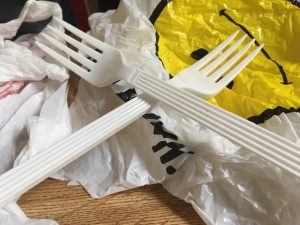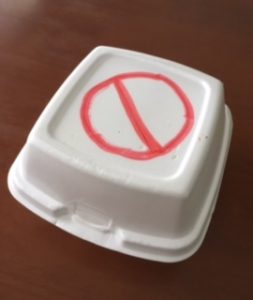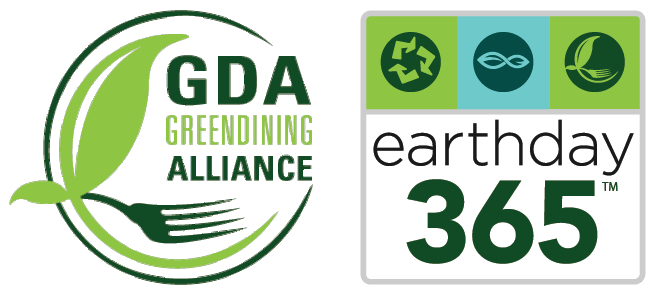We’re nearing the end of Plastic Free July, but that doesn’t mean it’s time to stop using your reusable coffee cups! In a world full of 7.5 billion people, it’s sometimes easy to sit back, sip out of our single-use plastic straws, and hold onto the mindset that one single person’s actions don’t make a difference – but the cumulation of these thoughts can hinder progress.
While the ubiquity of single-use plastics can feel overwhelming, simple changes can make a difference! Reducing your plastic use or attempting to go plastic-free is a challenge worth taking year-round, even if there are some hiccups along the way. According to the Plastic Free July campaign, more than 6 out of 10 of us are already refusing plastic bags – that’s an encouraging start, but there’s still room to improve. The average American family takes home about 1,500 plastic shopping bags a year, and only returns roughly 1% of those to be recycled. A simple switch to reusable bags would keep those leftover 1,485 plastic bags out of landfills. That’s a huge difference! If you’re having trouble remembering your reusable bags, leave backups in your car for when it’s time to stock up on groceries. Reusable bags are useless if you don’t, well, use them.

Single use plastic trash is nothing to smile about
One of the simplest ways to reduce plastic use is to stop buying plastic water bottles. Americans consume 8.6 billion gallons of bottled water per year; globally, the amount is 6 times that. Only 1 in 5 water bottles are recycled, meaning that the other 4 contribute to the 3 billion pounds of water bottles that end up in landfills each year. Next time you’re on the go, skip the plastic bottled water and just fill up at home. Plenty of establishments have no problem refilling it, and water refill stations are popping up everywhere!
Coffee cups are another single-use plastic culprit, both at home and on the go. Next time you need a caffeine fix, skip the single-serve coffee pods – these little guys can’t be recycled and end up in the landfill. Brew your own coffee the old-fashioned way, or purchase reusable, refillable pods. Swinging by a coffee shop instead? Bring your own travel mug. You’ll keep a paper cup and plastic lid out of the trash, and might even save a little change; some coffee shops (especially GDA-certified shops), offer a discount to customers that use their own mugs.
Plastic straws and utensils can sometimes seem like one of the hardest things to avoid. Over 500,000,000 plastic straws are used in the United States each day. If you’re ordering at a restaurant, ask your server to skip the straw. Do you really love straws, and don’t want to give them up? Purchase a reusable steel straw and just keep it in a bag or your car – then you’ll have it when you need it. A great alternative to plastic silverware is a reusable set, like the bamboo cutlery you can purchase from the GDA, or even a set of metal utensils you can keep in a desk drawer. Plastic silverware is a single-use item that can’t be recycled! Keep it out of the landfills, and don’t forget to tell restaurants that you don’t need a set with your takeout.

GDA bamboo cutlery is a stylish way to protect the environment.
Shipping materials are another non-recyclable plastic culprit that can feel unavoidable. Online shopping may be your preferred method for shopping, and while the act may save you time, it can also increase your environmental impact. If you’re already out and about, grab what you need from the store and skip ordering it from an online seller. If you need to ship something, reuse packing materials from packages you’ve received, or, stuff your packages with old newspapers! Some vendors can accommodate requests for zero plastic or Styrofoam packaging – just ask!
If you can only give up one kind of single-use plastic, try banning Styrofoam from your life. 3 million tons of Styrofoam are currently produced in the United States annually, 80% of which is destined for the trash. This single-use plastic takes up 30% of landfill space and takes over 500 years to break down! Though labeled with the #6 and accompanied by the friendly-but-deceptive recycling symbol, Styrofoam can’t actually be recycled for a variety of reasons. 20% of it actually ends up in our waterways, where birds and fish continually mistake it for food. Not only is it terrible for the environment, it isn’t good for the consumer either! Made of styrene, benzene, and pentane, these compounds can leach into the foods and drinks that are held in Styrofoam containers.

Refuse to use styrofoam when you dine out.
Becoming mindful of your plastic use is a great way to reduce your environmental impact; reuse what you can, and recycle the rest.
-Aspen Steiner




